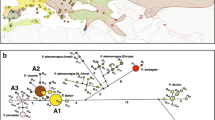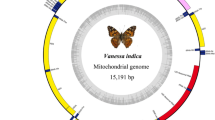Abstract
The present work involves the assessment of level of genetic relatedness or divergence amongst the six North-Indian species of Lepidoptera belonging to family Pieridae and sub family Pierinae on the basis of sequence variation of 16S ribosomal RNA. The PCR amplified products of these species were directly sequenced using ABI Prism BigDye Terminator Sequencing Kits (Applied Biosystems). The multiple nucleotide sequence alignment analysis has revealed several differences across these species. Significantly high percentage of A + T base composition content ranging between 73.13% (Ixias pyrene ) and 79.20 % (Pieris brassica) was observed in studied species. The percentage divergence in the investigated species of Pieridae family varied from 5.5% to 21.7%. The two species of Catopsilia revealed minimum sequence divergence of only 5.5%, whereas the other two groups of Ixias and Pieris revealed 15.5% and 8.6% sequence divergence, respectively. Pieris canidia and Ixias pyrene are genetically most divergent (21.7%) amongst the studied lepidopteran species. Phylogenetic analysis based on 16S rRNA nucleotide sequence revealed grouping of six species of Lepidoptera in the form of two different clusters, each cluster being represented by two species from the same genera. The separate taxonomic grouping of these Indian species has been observed when compared with several species of Piernae and Coliadinae subfamilies from other country isolates.
Similar content being viewed by others
References
Holloway JD, Bradley JD, Carter DJ (1987) IIE guides to insects of importance to man. 1-Lepidoptera. International Institute of Entomology and the Natural History Museum, London
Scoble MJ (1995) The Lepidoptera: Form, function, and diversity. Oxford University Press, New York
Xiang B, Kochar TD (1991) Comparison of mitochondrial DNA sequences of seven morphospecies of black flies (Dioptera). Genome 34: 306–311
Fang Q, Black WC IV, Blocker HD, Whitcomb RF (1993) A phylogeny of new world Deltocephalus like leafhopper genera based on mitochondrial 16S ribosomal DNA sequences. Mol Pylogenet Evol 2: 119–131
Kambhampati S (1995) A phylogeny of cockroaches and related insects based on DNA sequence of mitochindrial ribosomal RNA genes. Proc Natl Acad Sci USA 92: 2017–2020
Tang J, Pruess K, Cupp EW, Unnasch TR (1996) Molecular phylogeny and typing of blackflies (Diptera: Simuliidae) that serve as vectors of human or bovine onchocerciasis. Med Vet Entomol 10: 228G–234
Alaine W, Brower AVZ, Lee Ming-Min, Willmott KR, Mallet J (2005) Phylogenetic utility of Tektin, a novel region for inferring systematic relationships among Lepidoptera. Ann Entomol Soc Am 98(6):873–886
Martin JA, Pashley DP (1992) Molecular systematic analysis of butterfly family and some subfamily relationships(Lepidoptera: Papilionoidea). Ann Entomol Soc Am 85: 127–139
Pashley DP, Ke LD (1992) Sequence evolution in mitochondrial ribosomal and ND-1 genes in Lepidoptera: Implications for phylogenetic analyses. Mol Biol Evol 9: 1061–1075
Shouche YS, Patole MS (2000) Sequence analysis of mitochondrial 16S ribosomal RNA gene fragment from seven mosquito species. J Biosci 25(4): 361–366
Jenkins TM, Dean RE, Verkerk R, Forschler BT (2001) Phylogenetic analyses of two mitochondrial genes and one nuclear intron region illuminate European subterranean termite (Isoptera: Rhinotermitidae) gene flow, taxonomy, and introduction dynamics. Mol Phylogenet Evol 20: 286–293
Austin JW, Szalanski AL, Cabrera BJ: A phylogenetic analysis of the subterranean termite family Rhinotermitidae (Isoptera) using the mitochondrial cytochromeoxidase(COII) gene. Ann Entomol Soc Am 2004 (in press)
Nagaraja GM, Nagaraju J: Genome fingerprinting in silkworm, Bombyx mori using random arbitrary primers. Electrophoresis 16: 1633–1638, 1995
Roerdanz RL: Amplification of complete insect mitochondrial genome in two easy pieces. Insect Mol Biol 4: 169–172, 1995
Avise JC: Molecular markers, natural history and evolution. London: Chapman and Hall, 1994
Rod E, Lyn BS, Farrell BD (2006) The provenance of old world swallowtail butterflies, Papilio demoleus (Lepidoptera: Papilionidae), recently discovered in the new world. Ann Entomol Soc Am. 99(1): 164G–168
Ausbel FM, Breut R, Kingston RE, Moore DD, Sideman JG, smith JA, Struhl K: Short protocols in molecular biology. John Wiley and Sons, Inc., 4: 15–37, 1999
Simon C, Frati F, Beckenbach A, Crespi B, Liu H, Flook P (1994) Evolution, weighting, and phylogenetic utility of mitochondrial gene sequences and a compilation of conserved polymerase chain reaction primers. Ann Entomol Soc Am 87: 651–701
Zimmermann M, Wahlberg N, Descimon H (2000) Phylogeny of euphydryas checkerspot butterflies(Lepidoptera:Nymphalidae) based on mitichondrial DNA sequence data. Ann Entomol Soc Am 93(3): 347–355
DeSalle R (1992) The phylogenetic relationships of flies in the family Drosophiladae deduced from mtDNA sequences. Mol Phylogenetic Evol 1: 31–40
Brown WM, Prager EM, Wang A, Wilson AC (1982) Mitochondrial DNA sequences of primates: tempo and mode of evolution. J Mol Evol 18: 225–239
Topal MD, Fresco JR (1976) Complementary base pairing and the origin of substitution mutations. Nature (London) 263: 285–289
Author information
Authors and Affiliations
Corresponding author
Rights and permissions
About this article
Cite this article
Sobti, R.C., Sharma, V.L., Kumari, M. et al. Genetic relatedness of six North-Indian butterfly species (Lepidoptera :Pieridae) based on 16S rRNA sequence analysis. Mol Cell Biochem 295, 145–151 (2007). https://doi.org/10.1007/s11010-006-9284-6
Received:
Accepted:
Published:
Issue Date:
DOI: https://doi.org/10.1007/s11010-006-9284-6




